10 Best Sleeping Pads for Backpacking in 2024
Check out the best lightweight sleeping pads for backpacking that the BFT team and I have tested for warmth, comfort, and durability for multi-day treks.
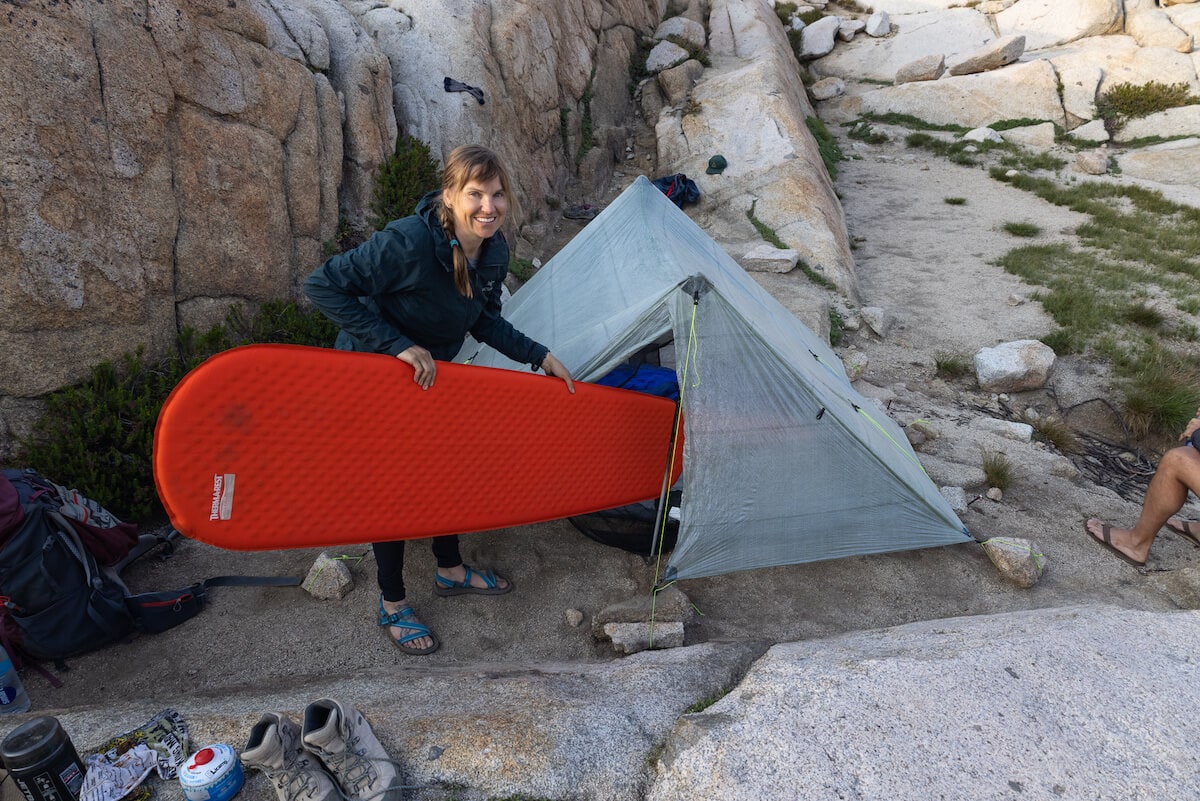
Sleeping on a leaky, halfway-deflated sleeping pad on a backpacking trip may leave you never wanting to go backpacking again. I’ve experienced this before and have learned the hard way that a quality sleeping pad is a crucial piece of gear.
Your sleeping pad can make or break your backpacking trip. There are a lot of factors that go into finding the best backpacking sleeping pad including price, insulation, weight, size, and even personal sleeping habits.
At Bearfoot Theory, my team and I have tried and tested numerous sleeping pads over the years – some better than others. In this blog post, I help you narrow it down by sharing my favorites. I slept like a baby on my backpacking trip to Sequoia National Park, and I believe that was because I had a good sleeping pad.
I realize every backpacker has a different budget and priorities, so this list highlights the most popular sleeping pads for every outdoor enthusiast from super lightweight options for those looking for the best ultralight backpacking gear to warm four-season ones and more.
This blog includes the 10 best sleeping pads for backpacking that my team and I recommend for beginner backpackers, thru-hikers, and everyone in between.

Best Backpacking Sleeping Pads at a Glance
- My favorite: Therm-a-Rest ProLite Plus
- Lightest sleeping pad: Therm-a-Rest NeoAir XLite
- Easiest to inflate: Sea to Summit Ultralight Insulated Air
- Comfiest backpacking pad: Sea to Summit Women’s Ether Light XT Insulated Air
- Best for side sleepers: NEMO Tensor Trail Ultralight Insulated
- Best 2-person pad: Exped Ultra 3R Duo
- Best 4-season pad: Exped Ultra 7R
- Best foam pad: NEMO Switchback Ultralight
- Best budget option: REI Co-op Trailmade Self-Inflating
- Best pad with side rails: Klymit Insulated V Ultralite SL
This post may contain affiliate links.
Save this post!
Enter your email & I'll send this post to your inbox! You'll also receive my weekly newsletter full of helpful advice for planning your adventures.
Therm-a-Rest ProLite Plus
My Favorite Sleeping Pad
Key Features (regular)
Where to shop
Backcountry
The Therm-a-Rest ProLite Plus is designed with comfort in mind, and it’s my personal sleeping pad of choice.
While it’s not the lightest sleeping pad available, I like that it’s one flat piece of padding without baffles.
At 1.5″ thick, it’s enough padding that you can’t feel the ground or little rocks that you might have set your tent up on top of. However, it’s not so thick that if you roll around at night, you feel like you might fall off.
It’s also insulated enough to camp in cold temperatures, but I recommend adding a foam pad underneath if you camp in the winter. There is a women’s version available as well which is a little shorter and warmer.
Compared to the other lightweight sleeping pads on this list, the Thermarest ProLite is a little on the bulky side when in the stuff sack, but it still packs down well enough to come along for the ride.
One other advantage is that it partially self-inflates. I like how I can just twist open the valve, the pad slowly starts to inflate on its own, and then I finish inflating it with my own breath.

Therm-a-Rest NeoAir XLite NXT
Lightest Sleeping Pad
Key Features (regular)
Where to shop
Overall, Therm-a-Rest seems to have the market cornered when it comes to warmth and lightness, making them one of the best brands of sleeping pads for backpacking.
Their Therm-a-Rest NeoAir XLite NXT will keep you warm and comfortable in the backcountry, and it’s the lightest inflatable sleeping pad that I stand behind.
BFT Contributor Linda Romero says, “This is my backpacking sleeping pad of choice. I’ve used it on over a dozen backpacking trips.”
The NeoAir XLite NXT does tend to run narrow, so if you toss and turn like me, I recommend getting the wide version.
It can also be noisy when you roll over so if you are a light sleeper keep that in mind, but I think for the weight and warmth, this sleeping pad is worth it. Linda says, “I like how it’s super lightweight and packs down very small.”
Sea to Summit Ultralight Insulated Air
Easiest Sleeping Pad to Inflate
Key Features (regular)
Where to shop
The Sea to Summit Ultralight Insulated Air Sleeping Mat is one of the best and most well-reviewed sleeping pads. It’s a lightweight and durable pad that’s easy to transport in and out of the carry bag.
One of the best features of this sleeping pad is that I can use the stuff sack to blow up the pad. I hook the stuff sack up to the valve, then I scoop up some air into the stuff sack, roll down the top, and force air into the sleeping pad. It takes less than a minute to fill up, and all your friends will be jealous as they huff and puff to blow their pads up. Using the stuff sack also reduces the amount of condensation built up inside the pad.
The valve on this sleeping pad is also one of the most durable valves on the market which is pretty huge considering valves are where common leakage happens.
As a bonus, the Sea to Summit Ultralight has an anti-microbial coating that keeps any nastiness from building up over time.
This sleeping pad also comes in a women’s version. If you’re like me and want a little more padding, I recommend the Sea to Summit Comfort Light Insulated Sleeping Pad (pictured below) as a great option.
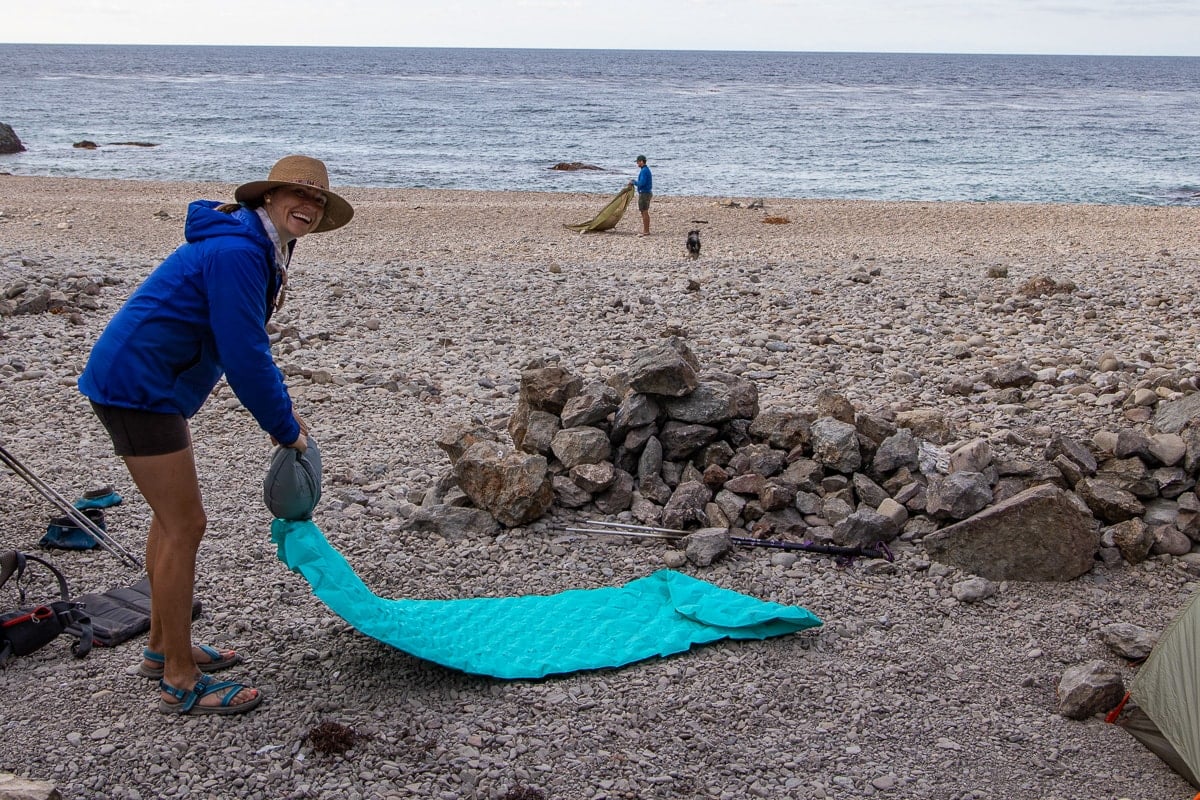
Sea To Summit Women’s Ether Light XT Insulated Air
Comfiest Backpacking Sleeping Pad
Key Features (regular)
Where to shop
The Sea to Summit Women’s Ether Light XT Insulated Air Sleeping Mat is the ideal sleeping pad for anyone seeking maximum comfort and who doesn’t mind carrying a little extra weight and bulk. The extra thick (XT) construction provides deep cushioning, perfect for side sleepers.
BFT Contributor Becky Timbers says, “I use this sleeping pad for my bikepacking adventures because it’s extremely comfortable.”
While it doesn’t pack down quite as small as other pads on this list, it’s still really lightweight at just over a pound. Becky says, “I am a side sleeper and don’t feel the ground at all while shifting from side to side on this pad.” The women’s version also has a slightly warmer R-value at 3.5.
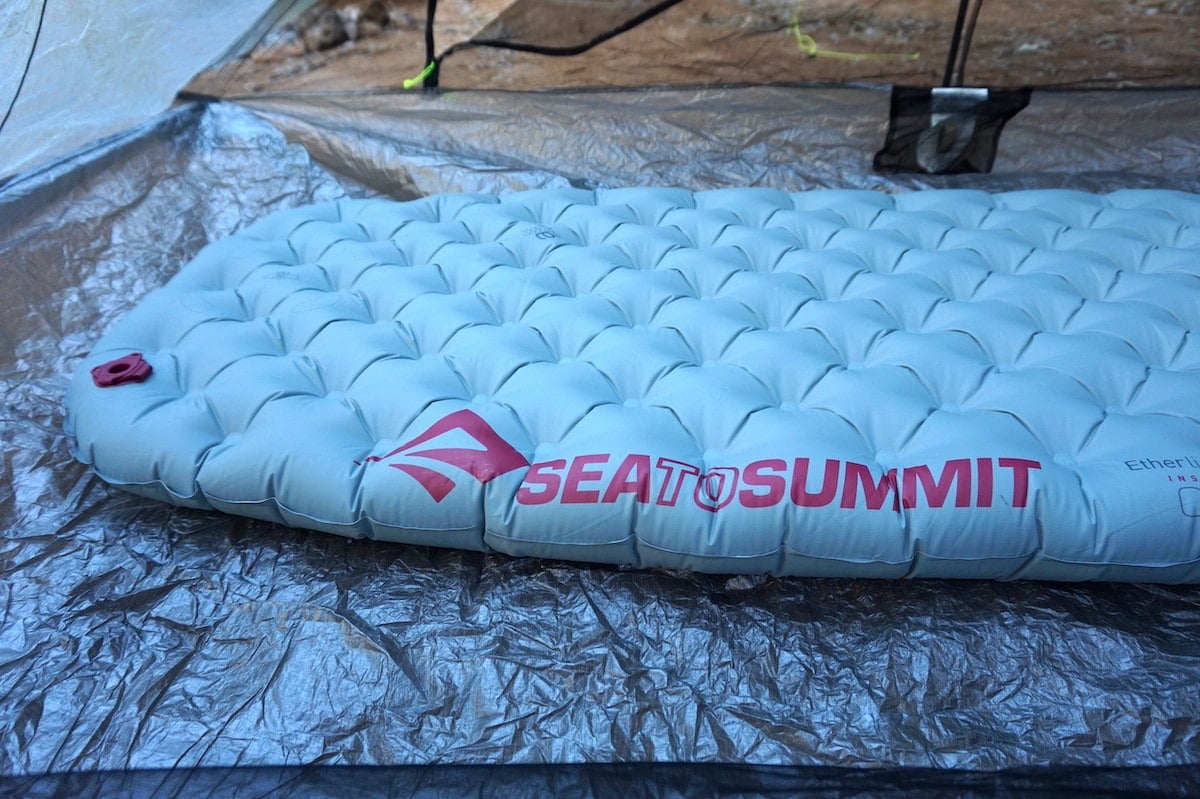
The Ether Lite XT comes with an Airstream Pump stuff sack, which allows you to inflate the pad without blowing into it. The sack is fully integrated into the sleeping pad bag, making it really easy to use (and impossible to forget or leave behind). The valve is durable and allows for easy inflation, quick deflation, and a button for fine-tuning the firmness when your pad is blown up without losing air.
This pad also comes with 4 “Pillow Lock” patches which secure any Sea to Summit backpacking pillow to the pad so it doesn’t slide off during the night — a common problem with most backpacking pillows. I personally love the Sea to Summit Aeros Pillow.
If you’re a side sleeper, tend to move around a lot, or are someone who wants to ensure a really good night’s sleep in the backcountry, this sleeping pad is definitely worth the money.
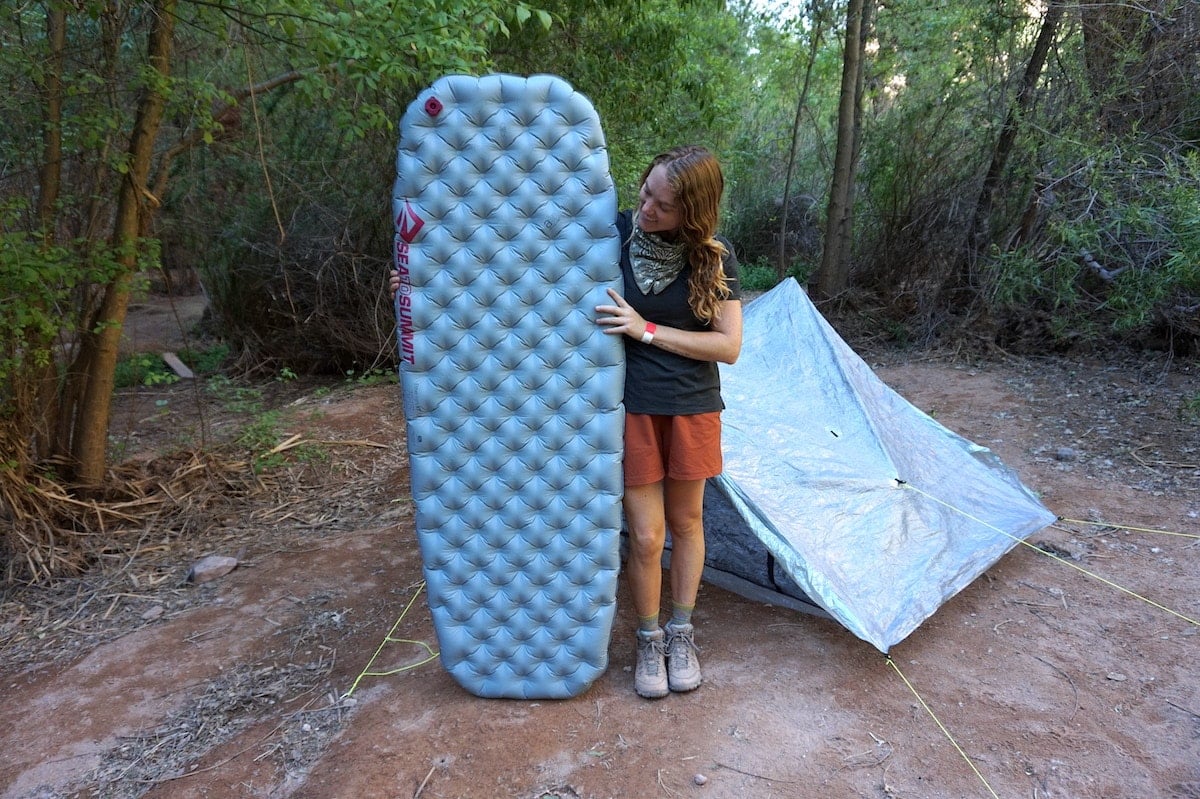
NEMO Tensor Trail Ultralight Insulated
Best Sleeping Pad for Side Sleepers
Key Features (regular)
Where to shop
If you’re a side sleeper, the NEMO Tensor Trail Ultalight Insulated sleeping pad is a great option.
It’s lightweight and has insulated layers to fend off cold and with a thickness of 3.5 inches, your hips and shoulders will be happy all night light.
The NEMO Tensor Trail packs down small and the high-volume valve makes it quick to inflate and deflate. Alternatively, you can use the inflation sack to inflate the pad when you’re at high altitudes and the air is thin.
I also love that this pad comes in a range of sizes of regular, wide, and long to accommodate all body sizes.
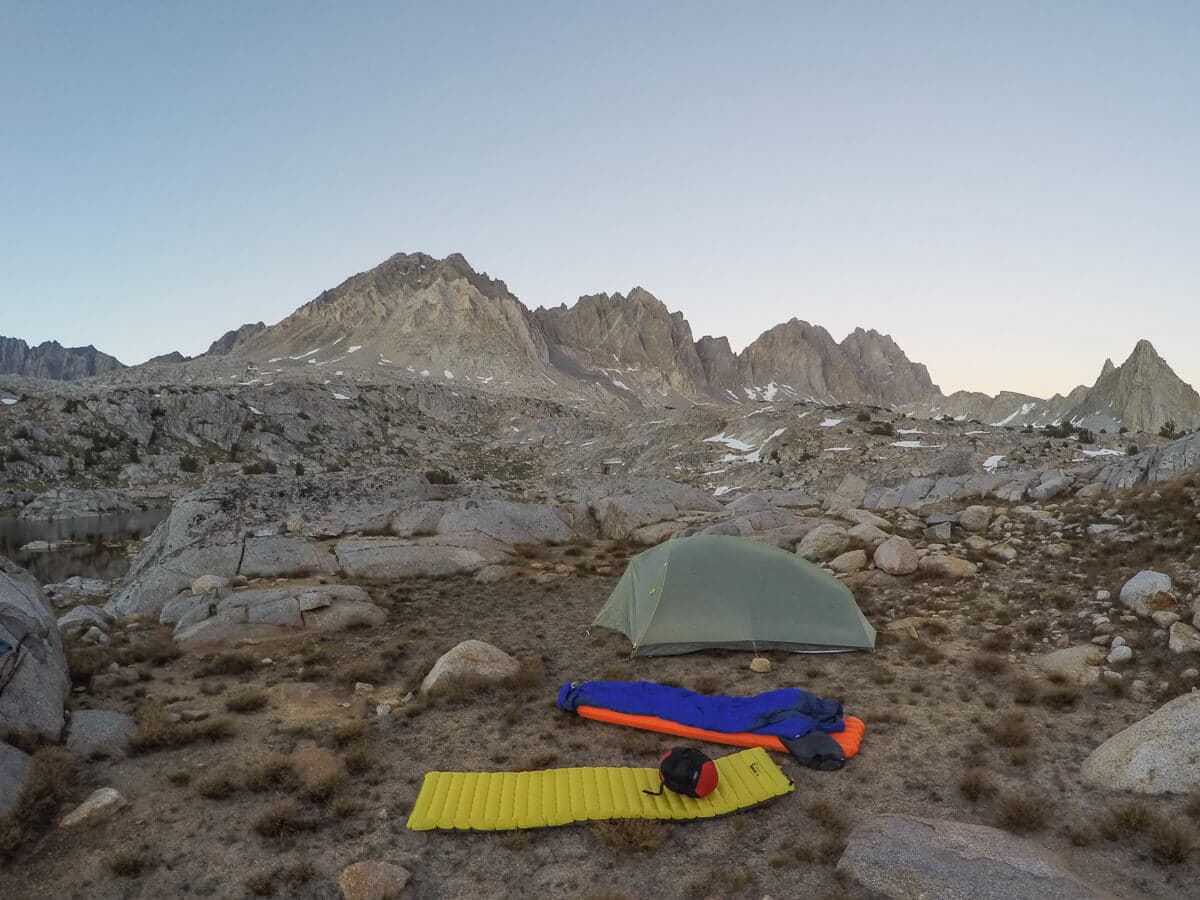
Exped Ultra 3R Duo
Best 2-Person Sleeping Pad
Key Features (medium)
Where to shop
Are you looking for a way to cuddle with your partner on backpacking trips? Look no further than the Exped Ultra 3R Duo Sleeping Pad.
This sleeping pad fits perfectly in two-person backpacking tents and is a great option for those looking to avoid uncomfortably pushing together 2 one-person pads.
You’d think that inflating a double sleeping pad would be more difficult than a single, but this sleeping pad is quick to inflate and deflate using a similar stuff sack mechanism as the Sea to Summit sleeping pad mentioned above.
The downside of this sleeping pad is its bulkiness and weight, but if you could split the weight into 2, it would be the same weight and size as some of the other sleeping pads I recommend on this list of the best sleeping pads for backpacking.
If you want a lighter-weight option with a lower R-value for summer camping, the Exped also comes in a 1R version. Be sure to check out my guide to the best double sleeping bags to pair with your 2-person sleeping pad!
Exped Ultra 7R
Best 4-Season Sleeping Pad
Key Features (medium)
Where to shop
Backcountry
This is one of the priciest sleeping pads on this list, but the Exped Ultra 7R Sleeping Pad is also the warmest by far with an R-value of 7.1.
It’s made for mountaineering and winter camping and backpacking, so if that’s the kind of thing you’ll be doing, then investing in an ultra-warm, comfortable, lightweight sleeping pad like this will be worth it in the long run. If you’re planning some winter camping trips, check out my best tips for staying warm this winter.
This pad is insulated with a layer of 700-fill down to keep you nice and warm even as the temperatures drop outside your tent.
The downsides of this sleeping pad are that it’s an expensive investment and the slippery material is noisy and easy to slide off of if you move around in your sleep.
NEMO Switchback Ultralight
Best Foam Sleeping Pad
Key Features (regular)
Where to shop
If you don’t like inflatable sleeping pads and prefer something simple that requires no setup time after a long day of hiking, check out the NEMO Switchback Ultralight Sleeping Pad.
This foam sleeping pad is lightweight and incredibly durable since you don’t have to worry about leaks or valve issues.
It’s pretty barebones and not quite as warm and comfortable as the other options on this list, but if you’re on a budget and want something simple, this is a good option for you.
Many reviewers note pairing this sleeping pad with an inflatable sleeping pad for extra padding and warmth on backpacking trips or using this pad as a sleeping space for their dog.
You can also use this sleeping pad as a sit pad when it’s folded up. The downside of a foam sleeping pad is it doesn’t compress like an inflatable pad does. For this reason, I typically carry my foam pad on the outside of my backpack.
REI Co-op Trailmade Self-Inflating
Best Budget Sleeping Pad
Key Features (regular)
Where to shop
If you are looking for a high-quality, budget-friendly sleeping pad, look no further than the REI Co-op Trailmade Self-Inflating Sleeping Pad.
With an R-Value of 5.5, this is a warm sleeping pad that is great for 3-season trips.
The price point makes it a good option for a budget camper or backpacker who is willing to sacrifice weight and packability.
The downside of this sleeping pad is the size – this is ideally a car camping sleeping pad, but it can also be used for short backpacking trips or if your backpacking sleeping bag and/or tent is small.
Klymit Insulated V Ultralite SL
Best Sleeping Pad with Side Rails
Key Features
Where to shop
The Klymit Insulated V Ultralite SL sleeping pad is an excellent 3-season pad for backpackers who like to sleep on their backs.
Although the pad is narrow, it includes side rails to prevent rolling off of it and help you stay on it throughout the night.
BFT Contributor Kaylin Zittergruen has used this pad on several backpacking trips and says, “This is my favorite sleeping pad for backpacking because it’s compact and inflates in 7-10 breaths.”
It also doesn’t make a peep when you change positions. Kaylin says, “I appreciate that this sleeping pad is quiet, lightweight, and comfortable. It’s a high-quality pad for an affordable price.”
The main downside to this pad is that it runs narrow and only comes in one size. I wish there was a wide version available for people who want more room to stretch out.
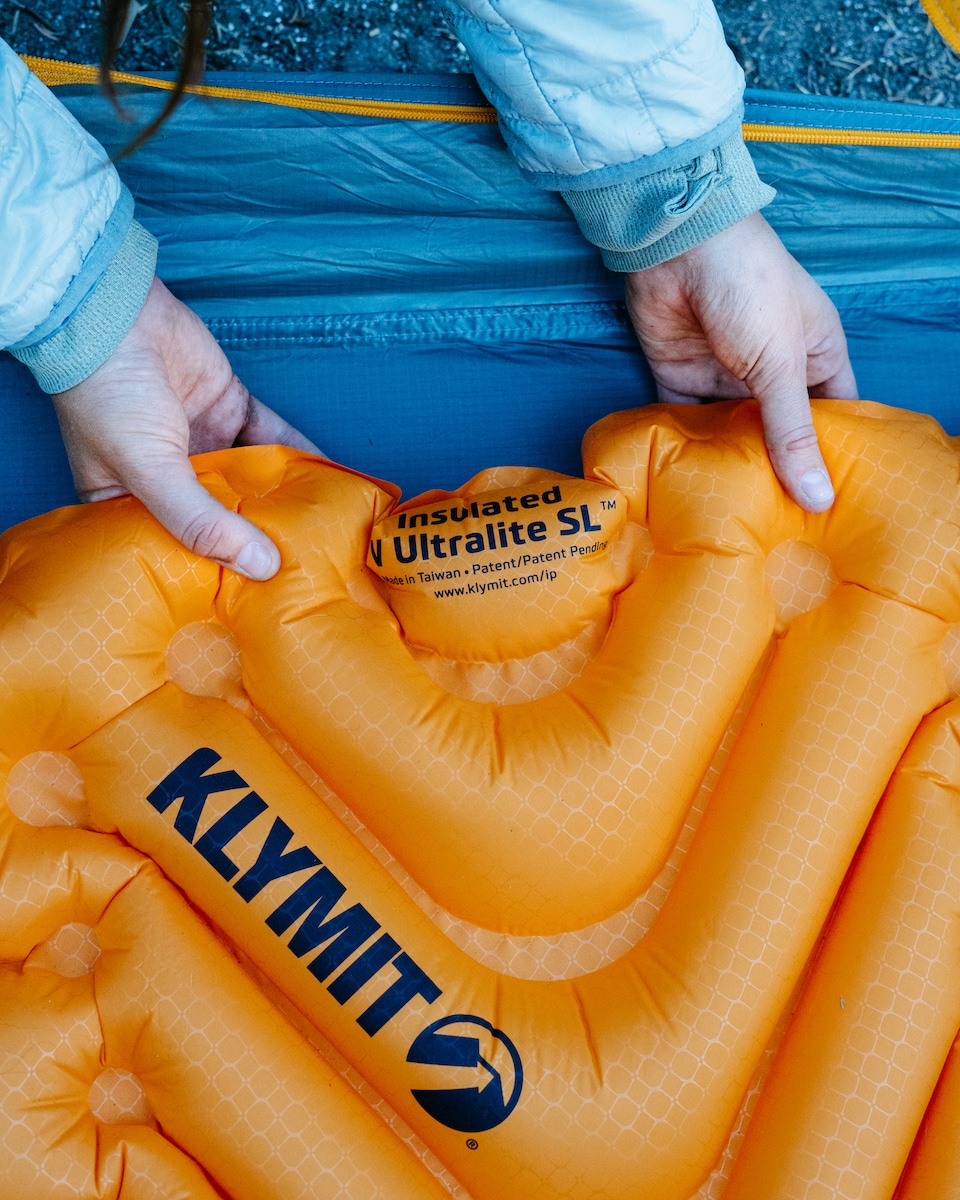
How to Choose the Best Sleeping Pad for Backpacking
I owned the same old sleeping pad for a long time since I started backpacking more than a decade ago, but a few years back, I decided it was time to upgrade. Since my original investment, sleeping pads have come a long way. Now they are lighter, more comfortable, and much more compact than ever before.
In my search for the best backpacking sleeping pad, I became overwhelmed with the number of options. There was a lot to consider like price, R-Value, weight, and size. So I did a bunch of research on how to choose the best sleeping pad for backpacking and wanted to share with you what I learned.
So, how do you choose the best sleeping pad for backpacking? Here are the factors to consider when making your purchase:
Foam Sleeping Pads vs Inflatable Sleeping Pads
There are two basic types of sleeping pads. The first is a closed-cell foam pad. These are the cheapest and most durable pads available, but they tend to be less comfortable.
Their stiff shape also means you don’t have the ability to pack them down, and most people end up carrying them on the outside of their pack.
The other option is an inflatable sleeping pad. These can either be self-inflating or manually inflated by blowing air into them.
These provide more cushion than a foam pad but are less durable since they are prone to puncture. I suggest being very careful when using an inflatable sleeping pad directly on the ground in order to avoid leaks.
Inflatable sleeping pads are significantly more comfortable than foam pads, and in many cases the difference in weight is negligible.
Insulation: The R-Value
The R-value is an indicator of insulation. R values range from 1.0 on the low end to 10 on the high end, and the higher the R-value the more heat the pad is going to retain. Most sleeping pads intended for backpacking have R-values around 2.0-5.0.
The first thing you’ll want to think about is the type of climate you’ll be using your sleeping pad in. If you are a fair-weather backpacker and will be spending most nights in warm summer temperatures, then you can get away with a lower R-value.
On the other hand, if you are doing winter or snow camping, then you will want something with an R-value closer to 5. Pads with R-values higher than 5 are heavier and generally intended for car camping.

Weight
Weight is an important factor to consider for all of your gear and sleeping pads are no exception.
Closed-cell foam pads are the lightest and generally weigh in at less than a pound.
The lightest inflatable sleeping pads are relatively comparable in weight to the foam pads.
Depending on how plush you want to go, a reasonable weight range for an inflatable air pad is 10 ounces up to 2 pounds. And while not always the case, there tends to be a tradeoff between weight and durability with inflatable sleeping pads.
If you choose one of the ultralight inflatable options, you need to treat it with caution and avoid using it directly on the ground.
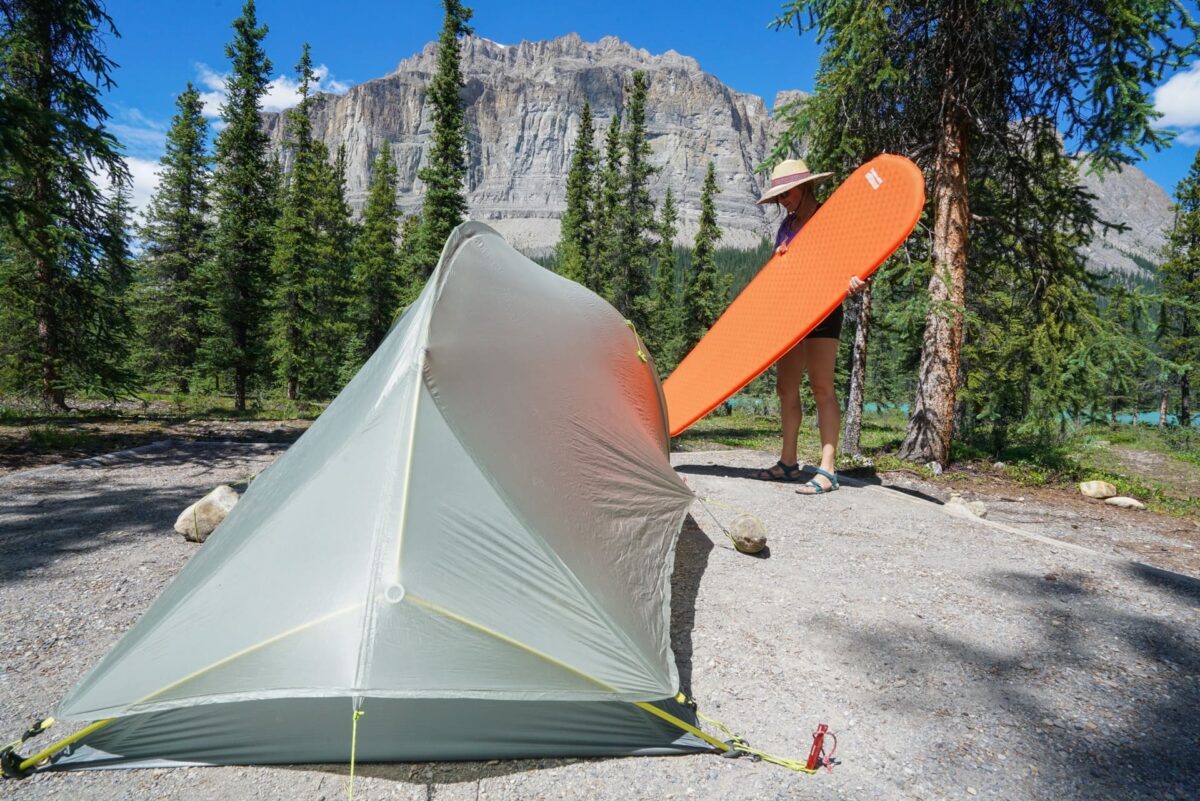
Thickness
Inflatable sleeping pads vary anywhere from one to four inches thick and a thicker pad is going to offer additional comfort if you are a side sleeper.
The downside of a thicker pad is that they take longer to inflate by mouth. If you are a back sleeper and tend to stay put throughout the night, then you might be ok with a thinner pad.
Closed-cell foam pads tend to be thinner, usually running at less than 1 inch thick.
Length and Width
In order to cut down on weight, sleeping pads are getting smaller and smaller. In fact, some sleeping pads now come in 3/4 length meaning the bottom of your legs and feet will be hanging off.
Many also have a tapered or mummy-shaped design where the head and foot are narrower than the rest of the pad.
While it varies across brands, a regular-sized sleeping pad is approximately 72 inches long by 20 inches wide, and most brands make their sleeping pads in multiple sizes to accommodate those who are shorter, taller, or have broad shoulders.
If you move around a lot while you sleep, you may want to buy a wide sleeping pad.
Women’s Backpacking Sleeping Pads
Some backpacking sleeping pads come in a women’s specific version. These tend to be shorter and are sometimes a little wider to accommodate various body shapes and larger hips.
Women’s sleeping pads are also made to be warmer, with a higher R-value since women often sleep colder than men.
Packed Size
This is one area where sleeping pads have made some serious advancements. Some sleeping pads these days are smaller than a Nalgene bottle when packed down, meaning they take up way less space in your bag than they used to.
For backpacking, you’ll want something that packs down to about 4-5.5 inches by 8-11 inches.
Of course, you can use something larger, but we’d only recommend that for shorter trips or if you’re splitting up gear between your partner or campmate.
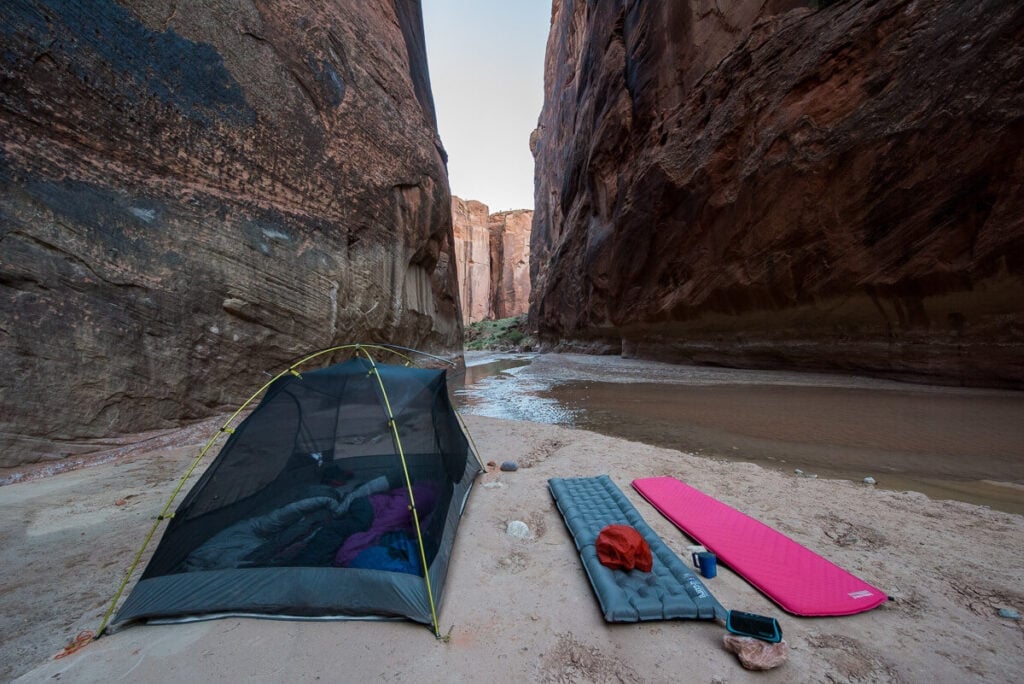
Other Features
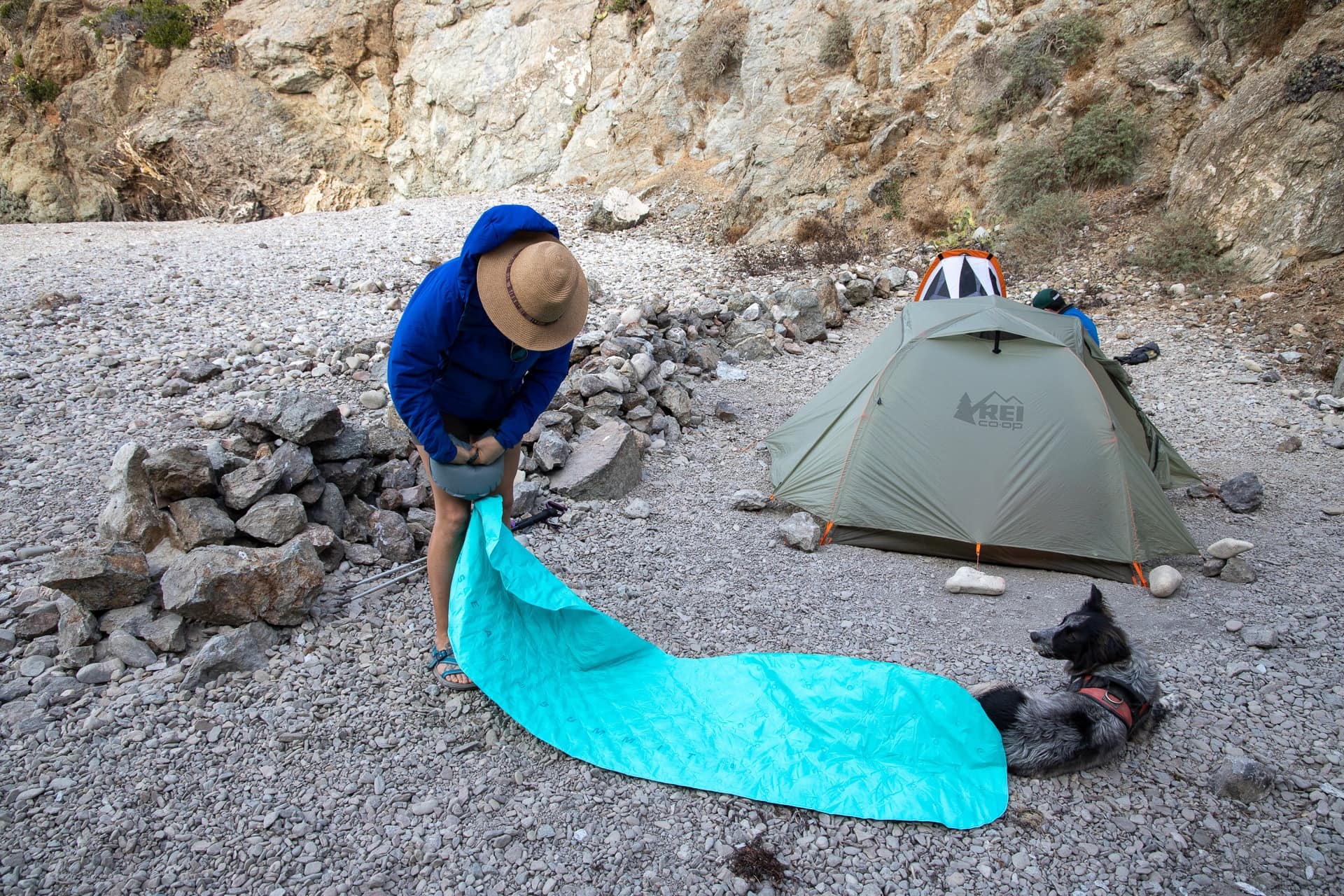
Frequently Asked Questions
I recommend choosing a sleeping pad that is a few inches longer than your height. You don’t want your feet to hang off of the pad as this could also make your body colder at night. When shopping for a sleeping pad, pay close attention to the dimensions they provide to help you determine if you need a short, regular, or long pad.
If you’re camping in conditions where the temperature could fall below 40-50 degrees Fahrenheit, I recommend bringing an insulated sleeping pad. Keep in mind the temperature is often chillier in mountainous areas in high elevations, so I prefer to use an insulated pad when backpacking in these regions (even in the summertime).
Although you can put your sleeping pad inside of your sleeping bag, this is uncommon and not the intended design of most pads. I put my sleeping pad underneath my sleeping bag.By sleeping with my pad beneath my bag, I get the best insulation from the cold ground and added comfort as I sleep.
Winter sleeping pads tend to have high R-Values to provide maximum insulation to keep you warm in cold weather. You can use a winter sleeping pad in the summer, though it may add more weight and be less compact than a summer sleeping pad. I do not recommend using a summer sleeping pad in the winter, though, as you could put yourself at risk for freezing and hypothermia.
READ NEXT
Looking to upgrade your gear closet? Check out my other backpacking gear round-ups:
Save this post to Pinterest
What is the best sleeping pad for backpacking that you’ve found? Do you have a favorite? Leave a comment below and let me know!

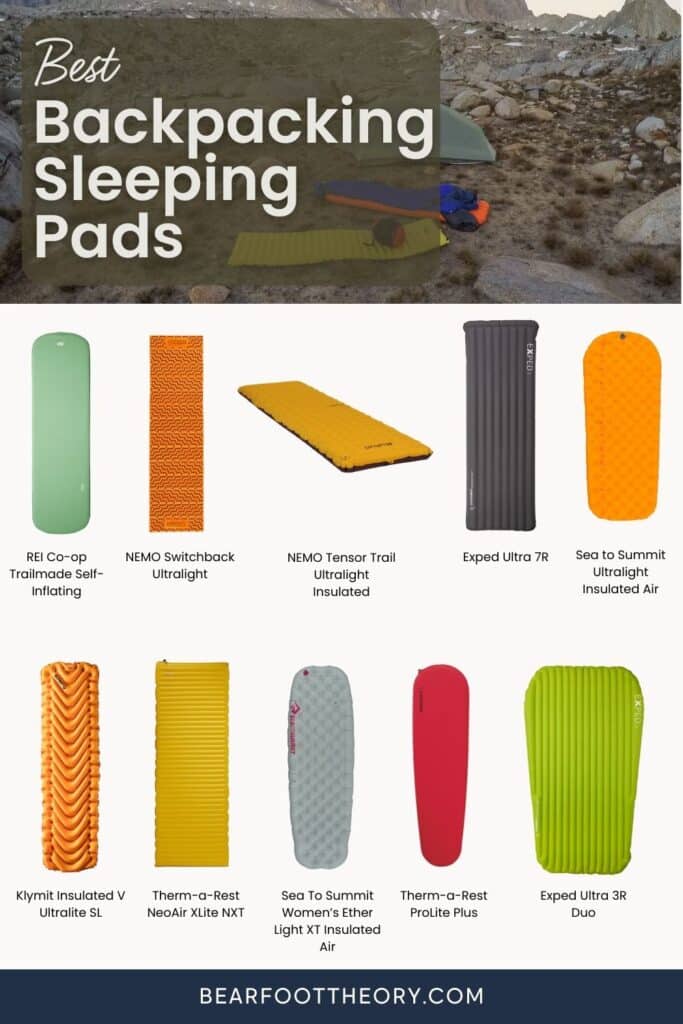
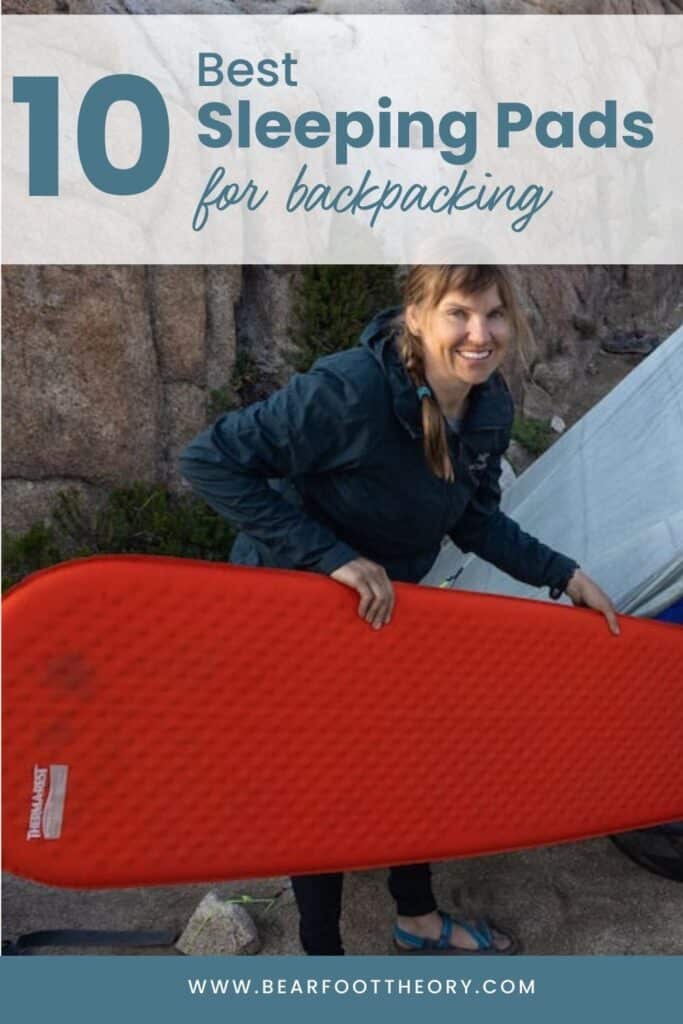
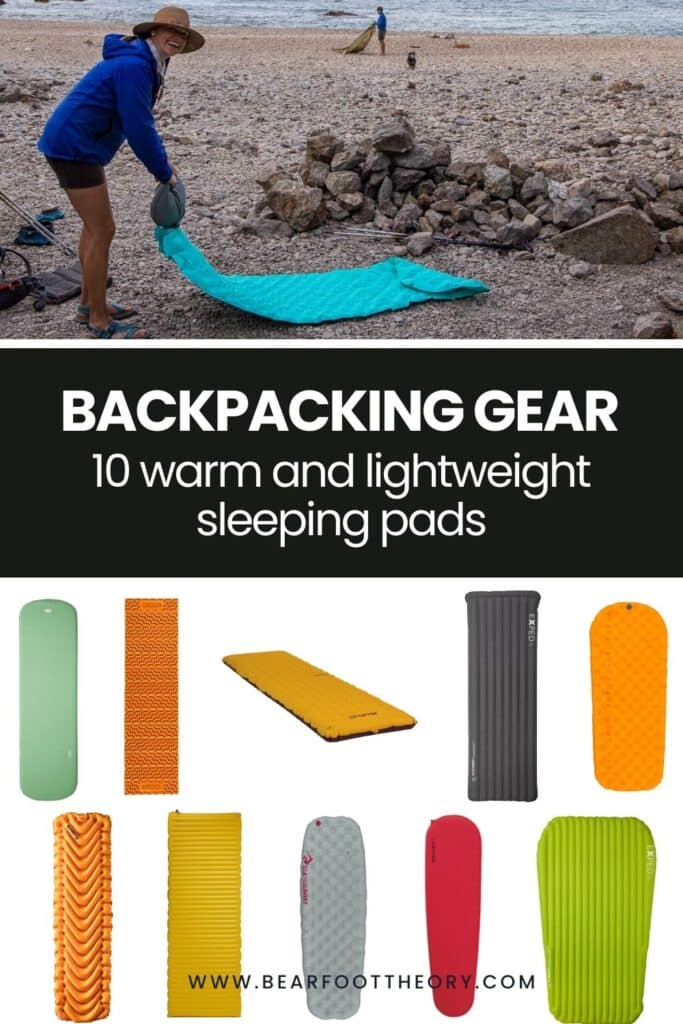
I wish I could remember the brand, but I came across a hiker who inserted his inflatable sleeping pad directly into his sleeping bag. I thought that was truly innovative! I recall the brand consisted of large “cup” holes throughout. Would love to know if there is a brand that is meant to go into your bag as I often find my sleeping bag slipping off.
I suppose any sleeping pad can slip inside a bag if it fits. I’m not aware of any brands that make specifically make sleeping pads to fit inside sleeping bags, though.
Based on the description of the large “cupholes” design, my guess is you are talking about the Klymit Inertia Ozone pad. I haven’t used that particular model, but I do use their Static V and insulted Static V pads and find them super comfortable.
My Big Agnes bag has a built in sleeve on the bottom of the bag for the air mattress to go in. I love it! I don’t backpack with that sleeping bag – I car camp with it.
I just switched to the NeoAir Xtherm and I LOVE it!